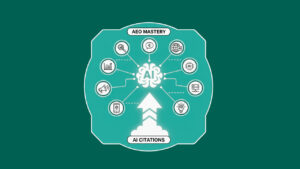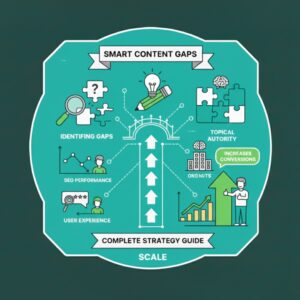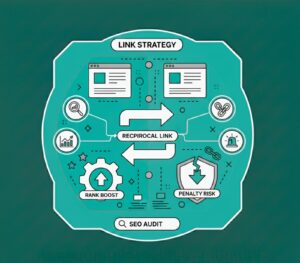AI and SEO Content Marketing ROI Explained: What B2B Companies Need to Know
Blogs | SEO
Written By: Lauren Davison
AI and SEO Content Marketing ROI Explained: What B2B Companies Need to Know
Blogs | Category
Written By: Lauren Davison
Introduction
In today’s rapid world, businesses are always looking for ways to get more from their marketing efforts. One of the key topics right now is AI and SEO Content Marketing ROI.
AI is reshaping B2B marketing by helping companies to create faster, smarter, and more targeted content. SEO ensures that the content reaches the correct audience at the right time.
But here’s the challenge: ROI is often misunderstood. Many companies face the struggle to measure the real impact of content investments, making it hard to justify budgets. Yet proving ROI is critical for long-term growth.
Without clear results, even the smartest AI tools or SEO strategies can feel like a gamble. This blog will show why ROI matters, how AI and SEO are changing B2B marketing, and what companies need to focus on to get real, measurable results.
Table of Contents
The New Role of AI and SEO in B2B Content Strategies
AI and SEO are changing the way B2B companies create and share content. Research happens faster. Messages feel personal. Content can grow without losing meaning.
SEO makes sure it reaches the right people. It includes increasing traffic and generating more leads. Every effort becomes measurable.
AI for Content Creation and Optimisation
AI turns content creation into a smart process. It helps generate ideas that matter. Then it organises keywords, so the content ranks higher and covers topics well. AI also adapts content to the reader with good tone changes and structure adjustments. Every reader gets relevant information.
Optimisation becomes quicker and smarter. Headlines, meta descriptions, and page content can be improved in minutes. When paired with an AI-driven SEO strategy, every post, guide, or article becomes precise, discoverable, and measurable.
The result? Content that reaches the right people, drives engagement, and delivers real B2B content marketing ROI.
SEO for Visibility and Demand Generation
SEO is more than keywords. It sets content in front of the right people at the right moment. Buyers are searching for solutions, and showing up when they need answers increases engagement.
Meta titles, descriptions, headings, and links work together to help search engines understand content. Relevant queries guide users to the correct pages.
An SEO visibility for B2B companies approach focuses on intent. What questions do buyers have? What challenges are they facing? Content is optimised to meet these needs, guiding prospects naturally through their journey.
Local search, long-tail keywords, and internal linking improve reach. Use analytics to track performance. The outcome: content is seen by the right audience, captures interest, and creates demand efficiently.
Challenges in Measuring ROI for B2B Content Marketing
Measuring ROI in B2B content marketing can be challenging. Sales cycles can last for months, sometimes even years. Leads pass through many steps, and linking each step back to a single piece of content is challenging. On top of that, some teams chase numbers that look good but do not prove value, like likes or page views.
The Problem of Multi-Touch Attribution
A buyer’s path is rarely a straight line. They bounce from blog posts to case studies, then a demo, an event, or even a quick LinkedIn scroll. Each moment shapes the decision, but no single moment tells the full story.
That is where attribution gets messy. Simple models give all credit to the first click or the final action. It feels neat, but it leaves most of the journey in the dark. More advanced models spread credit across steps; yet they need solid data and smooth systems working together.
The risk? You might think some content is not pulling its weight when it actually is. An early blog could spark awareness, planting the seed that grows into a deal months later. If you can’t see that link, it’s easy to cut useful content and double down on the wrong things.
Beyond Traffic – Measuring Business Value
Not all metrics are created equal. Clicks, impressions, and likes might look impressive on a dashboard, but they do not prove business impact. These vanity metrics show activity, not value. A post with thousands of views may still fail to bring in a single qualified lead.
What matters more are real performance indicators. Leads generated, opportunities in the pipeline, and closed revenue tell a clearer story. These KPIs connect content to growth, showing whether marketing is moving the business forward.
Vanity metrics show how many people you reach, while business KPIs show the real results. Traffic shows people saw the content, but smart B2B marketers judge success by leads, pipeline, and revenue.
A Framework to Calculate True ROI from AI & SEO Content
Calculating ROI doesn’t have to be complicated. A clear framework turns content performance into measurable numbers.
The simple formula looks like this: (Revenue Attributed to Content – Content Cost) ÷ Content Cost = ROI. This equation shows how much return you get for every dollar spent.
A step-by-step method helps B2B teams prove value.
- Track all costs: production, tools, distribution, and promotion.
- Attribute revenue: connect leads, pipeline, or deals back to specific content.
- Use the formula: subtract the cost from the revenue, then divide by the cost.
- Compare channels: see how AI content and SEO-driven pieces perform side by side.
- Refine strategy: use results to adjust budget, focus, and scale.
Different content ROI calculation methods may add layers, like customer lifetime value or multi-touch attribution, but the core principle stays the same: link investment to measurable return.
Define Clear Goals and Conversion Metrics
Before measuring ROI, set clear goals. B2B companies often jump to reporting without clarity, which makes numbers meaningless. Start by defining what success looks like.
- MQLs (Marketing Qualified Leads): Prospects who engage with content and match your target profile.
- SQLs (Sales Qualified Leads): Leads ready for a sales conversation, often influenced by deeper content.
- Influenced revenue: Deals where content played a role in moving the buyer forward.
Without these benchmarks, ROI turns into guesswork. With them, every asset can be tracked in relation to business growth. Goals transform data from noise into insight, making ROI measurable and credible.
Track Costs Accurately
ROI starts with knowing what you spend. Many B2B teams overlook hidden costs, which makes results look bigger or smaller than they really are. A clear view of spending builds a reliable baseline for measurement.
- Content creation: Include writer fees, design, editing, and video production. Every asset has a price tag.
- AI tools: Platforms for research, ideation, automation, and optimisation carry monthly or annual costs. These must be part of the equation.
- SEO optimisation: From keyword tools to technical audits and link-building efforts, SEO requires ongoing investment.
- Distribution: Paid ads, social promotion, email, and syndication also add to the total spend.
When all costs are tracked, AI and SEO content marketing ROI becomes a true reflection of impact. No inflated numbers. No guesswork. Just a clear picture of what content delivers compared to what it consumes.
Map Content to the Sales Funnel
Content works best when it matches the buyer’s stage. Each type plays a unique role. Some spark awareness, others nurture interest, and a few push for conversion.
- Awareness stage: Blog posts, guides, and infographics attract attention. They answer early questions and make prospects aware of a problem. Search-optimised blogs and shareable resources pull people in.
- Consideration stage: Case studies, webinars, and detailed comparisons show solutions in action. They build trust and help prospects weigh options.
- Decision stage: Whitepapers, demos, and product sheets deliver proof and detail. These resources give confidence to move forward.
Here’s where AI tools for content optimisation make a difference. They help tailor tone, structure, and keywords for each stage of the process. Blogs become easier to find.
Case studies become more engaging. Whitepapers align with buyer intent. The result? Every piece of content supports the funnel, guiding prospects step by step until they convert.
Tools and Analytics for Measuring ROI
Measuring ROI takes more than numbers in a spreadsheet. You need tools that connect content to outcomes.
- Google Analytics 4 (GA4): Tracks users across pages and apps. Shows where they come from, what they click, and when they convert. Custom events uncover the real path from content to lead.
- HubSpot: Brings CRM and marketing together. Maps the entire journey, from first interaction to closed deal. Clear visibility on what content drives revenue.
- SEMrush: Focuses on search performance. Monitors rankings, finds keyword gaps, and tracks backlinks. Helps you see how search visibility links to demand.
- Attribution dashboards: Pull data from different sources. Highlight which touchpoints matter most in the funnel. Reveal the hidden value of content that standard reports miss.
When used together, these tools give a full picture of AI and SEO content marketing ROI. They reveal which content works, which channels drive demand, and where investment delivers the highest return.
Case Study – Proving ROI Through AI with SEO Synergy
A mid-sized B2B software firm faced a problem: their blogs were live, but traffic stayed flat and conversions were weak. The team turned to AI-generated insights paired with SEO optimisation to fix it.
AI scanned customer data, search trends, and competitor gaps. It highlighted topics buyers were actually looking for. Instead of generic blogs, the company produced targeted content mapped to buyer intent.
SEO then refined it with keyword clustering, meta improvements, and technical fixes, pushing the pages higher in search results.
Within three months, organic traffic rose by 40%. More importantly, leads from content doubled. Case studies and whitepapers started driving direct opportunities into the sales pipeline.
This shows the power of AI with SEO synergy in marketing. AI uncovers insights. SEO ensures visibility. Together, they move content from being a cost to being a growth driver.
Conclusion – Making ROI a Continuous Process
ROI is not a one-time effort. It works like a cycle: measure, refine, and improve. Buyer needs change, search engines shift, and competitors adapt. A single snapshot never shows the full story.
With AI and SEO content marketing ROI, the focus should be on progress over time. AI uncovers new insights from data. SEO makes sure that content is seen and drives demand.
When combined, they keep performance steady and measurable instead of leaving results to chance.
Midland Marketing offers a clear example of how this approach can be applied. Their strategies focus on:
- Frequent audits: Update or remove weak content and spot fresh opportunities.
- Keyword shifts: Realign topics with how buyers search today, not last year.
- Conversion tracking: Connect leads and revenue back to content, not just clicks.
- Testing cycles: Small changes in tone, design, or structure that lead to steady gains.
When ROI tracking becomes a routine practice, growth becomes more predictable. It turns into a repeatable system where every piece of content works harder and delivers more value.
Frequently Asked Questions
1. What makes AI valuable in B2B content?
It cuts the time spent on research. It spots patterns in data and gives ideas that match what buyers want. Instead of long trial and error, teams can act with focus.
2. How does SEO help content reach the right people?
Search engines reward content that is clear, relevant, and structured well. With proper SEO, the right audience finds your work at the moment they need it most.
3. Why is ROI tricky to prove in marketing?
Many focus on clicks or likes, but those don’t show business value. ROI is about leads, deals, and revenue. Without linking content to these outcomes, numbers on a dashboard are meaningless.
4. What is the role of AI with SEO in synergy?
AI suggests what to create and how to shape it. SEO makes sure it can be found and ranked. Together, they close the gap between creating content and getting measurable impact.
5. How can teams build a habit of tracking ROI?
Start by setting a clear outcome, like qualified leads. Keep costs logged. Use dashboards to see what works. Review results often and refine the plan instead of waiting a year to adjust.

Written by - Lauren Davison
Introducing Lauren – one of our content writers who has a flair for SEO and creative strategy!
With a Master’s Degree in Creative Writing, Lauren has niched down into SEO and content writing.
Outside of work, she loves watching the darts, reading and the pub on the weekend.
Want some more?
Latest Insights & News

Revolutionising Marketing: The Rise of Situational Content Strategies
Situational content strategies involve tailoring content to specific moments, contexts, or audience behaviours. By aligning content with real-time trends, seasonal needs, and user intent, brands can increase relevance, improve engagement, and strengthen SEO performance.

Smart Ways to Identify and Fill Content Gaps Fast: A Complete Strategy Guide
Content gaps refer to missing information, unanswered questions, or underserved topics in your existing content. Identifying these gaps helps you create targeted, high-value pages that improve search visibility, satisfy user intent, and outperform competitors.

Reciprocal Links in SEO: Do They Still Boost Rankings or Risk Penalties?
For the keyword “reciprocal links SEO,” focus on explaining how reciprocal linking works today. Reciprocal links are not harmful by default, but Google can flag excessive or manipulative link exchanges. To stay safe, only exchange links when they are contextually relevant, natural, and valuable to users.
